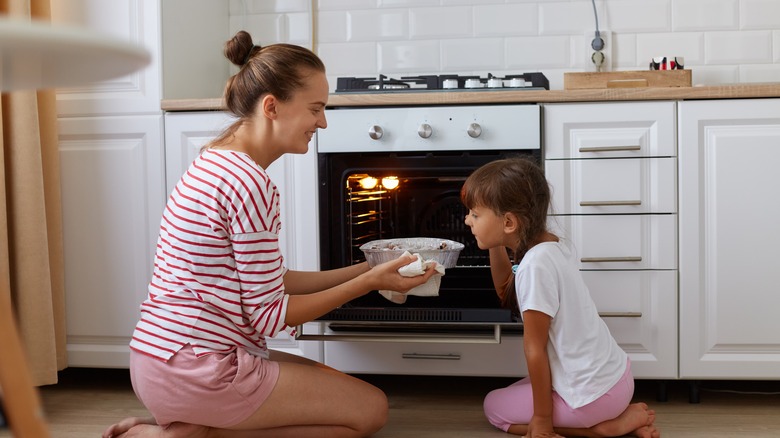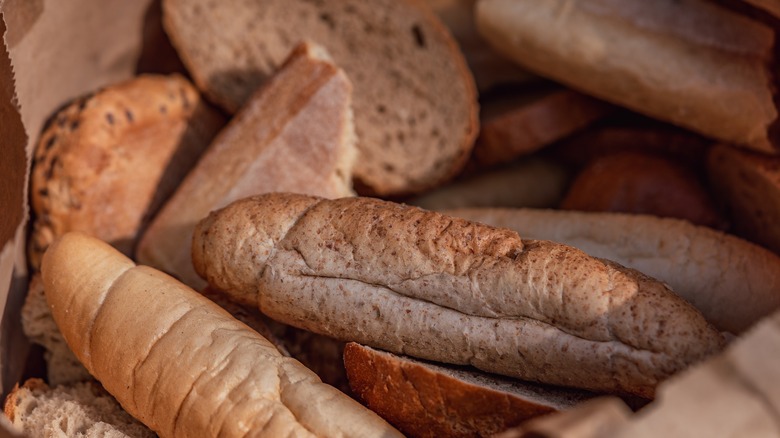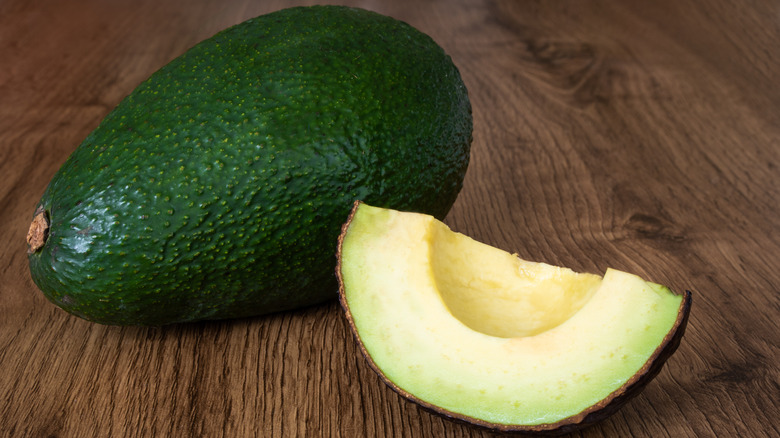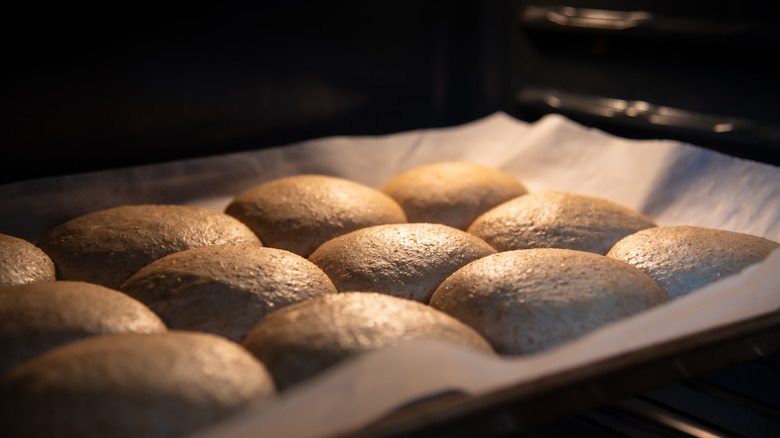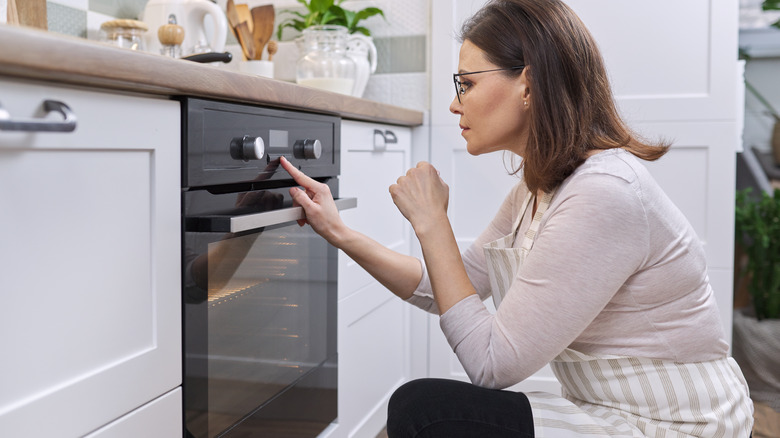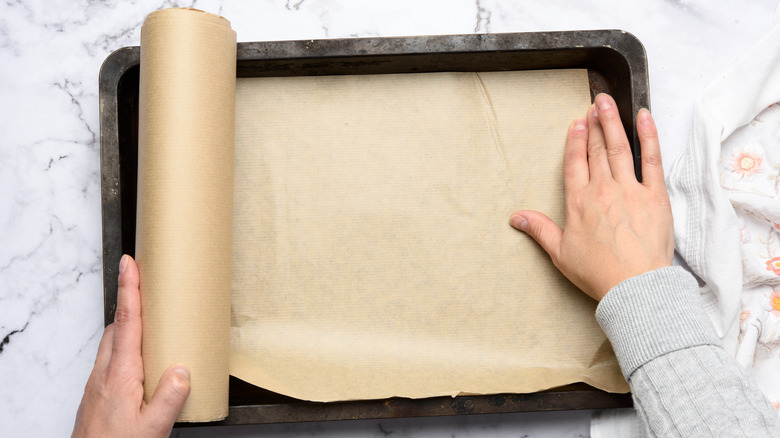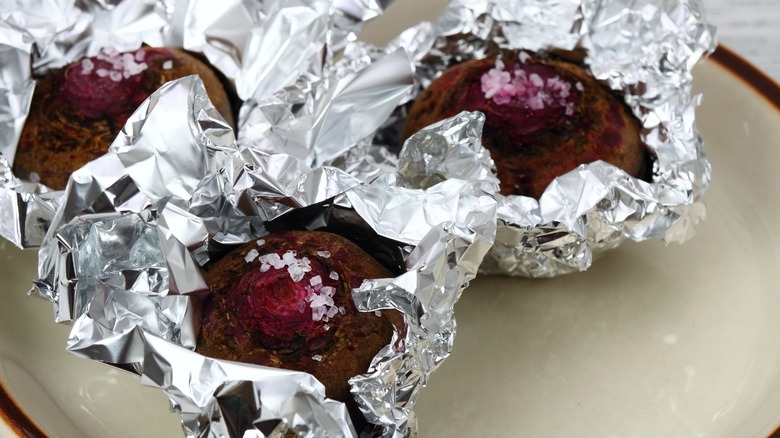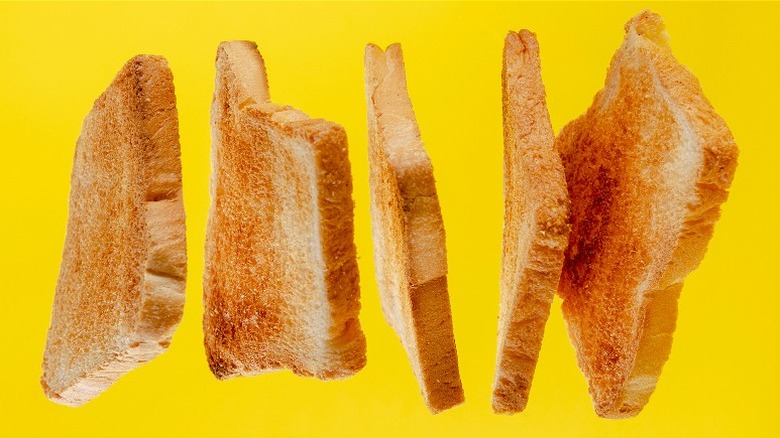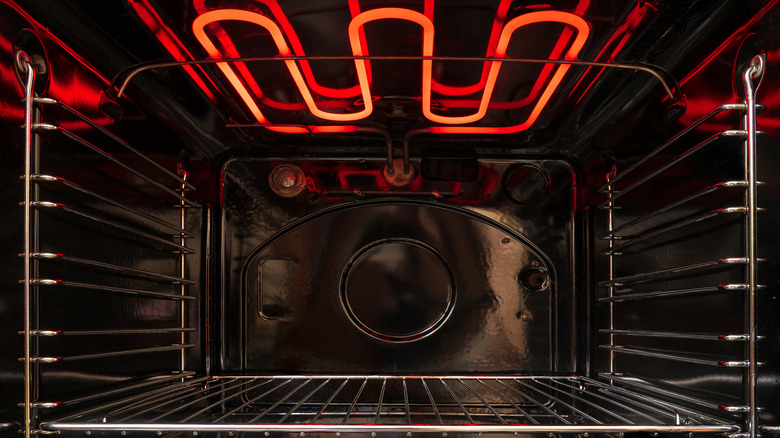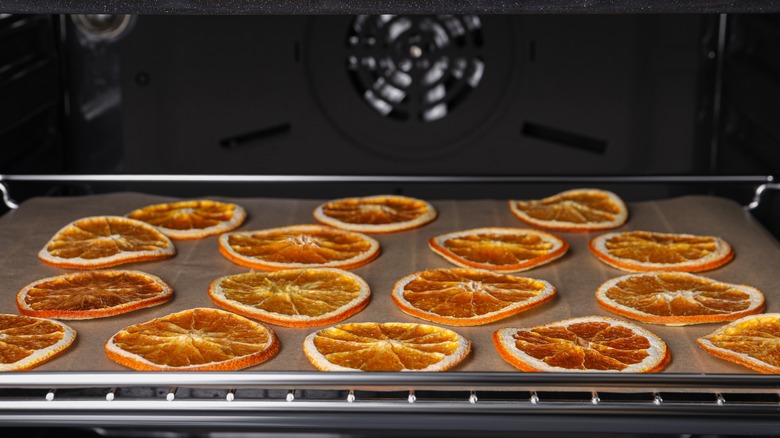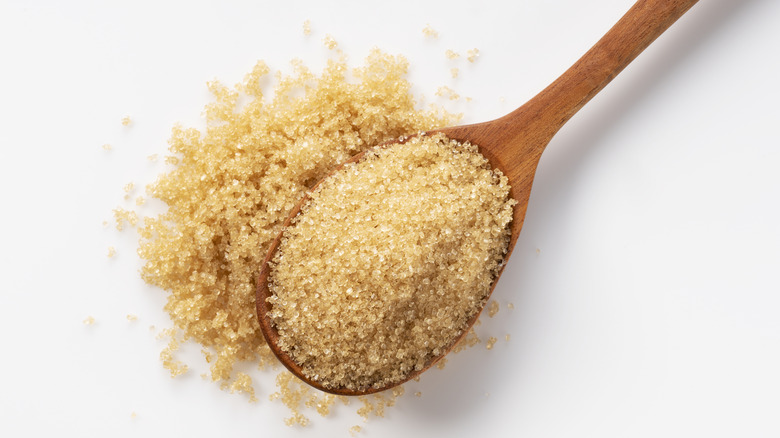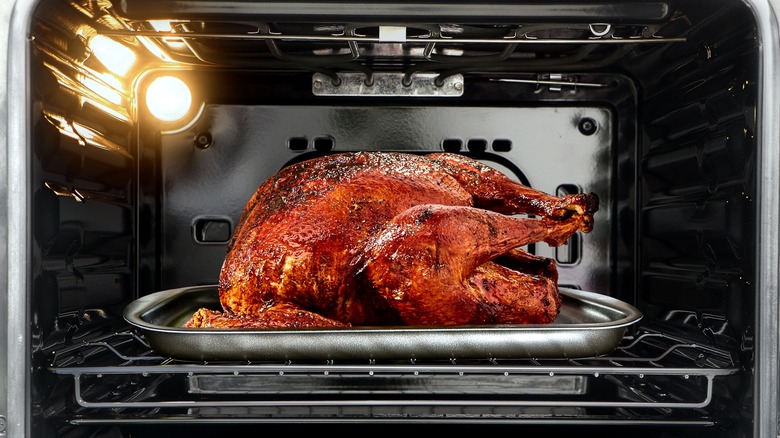12 Oven Hacks You Need To Start Using
The odds are that you don't take advantage of your oven as much as you should. Indeed, you might use it to make delicious dinners and roasted vegetables, because that's what these appliances are for, right? If you're a dessert lover, you probably also make batches of cookies and fudgy brownies. Yet, those items only touch the surface of everything you can do with an oven. Whether you own a convection or conventional oven, you can use it in creative ways that make your time in the kitchen a lot smoother.
From learning how to pinpoint the hot spots in your appliance to bringing stale or unripe foods to life, these tricks are nothing short of phenomenal. Additionally, the oven has the ability to function as other appliances, such as a toaster, proofing box, and dehydrator, too. Once you become acquainted with these hacks, the way you use your oven will change for the better.
1. Revive stale bread
When your beloved loaves of bread turn hard, putting it in the oven might be the last thing you think of doing. Although it seems counterintuitive, the oven saves the day with the help of a smidge of water. In a TikTok, one social media user showed precisely how this mind-blowing oven hack works. In the video, she explains that you can take your stale bread and lightly hydrate it with water (don't fully submerge it in the liquid, simply place it under a faucet and let the water run over it on all sides). Then, stick the piece of bread, without slicing it, directly into a 400-degree oven. Wait roughly five minutes, give or take, for the oven to work a miracle.
It might take a few minutes longer, depending on how much you saturated the bread. Check on the bread to see if its texture has improved enough; it should be perfectly crisp outside. Meanwhile, like a fresh loaf, the center is incredibly soft and chewy, with steam visibly escaping into the air. Of course, the steam comes from the water that you moisten the bread with, and the oven's heat reminds the crust that it should be crunchy. This hack works best with whole loaves.
2. Soften unripe avocados
You no longer need to change your dinner plans if your newly bought avocados seem unusable because they are not yet ripe enough. You can use a little heat from the oven to soften the fruit so you can use it in your recipes immediately. First, set the oven to 200 degrees Fahrenheit. Then, wrap the whole fruit in foil to protect the outer layer from the direct heat. Then, place the food on the rack.
Allow at least 10 minutes before you check on it, and if it still seems stiff, continually check it after 10-minute intervals until you are satisfied with its texture. Some people believe that the hot environment ripens the avocado, but Healthline warns that it's more of an illusion. The fruit doesn't mature, but it just becomes softer and more enjoyable to eat. This also means that the avocado doesn't contain all the nutrients you receive from a fully ripe avocado. Nevertheless, this approach is a lifesaver when you're in a pinch.
3. Proof dough
Did you realize your oven doubles as a dough-proofer? This hack benefits home bakers who don't own a proof box, which is a tool used to help accelerate and control the step of baking in which dough must rise. These tools create warmer and more humid environments, which aids in yeast activity. If you're using your oven in place of a proofer, you'll have to account for the lack of humidity in the oven. Instead, place a heat-safe bowl or container of water in the bottom of the oven to introduce moisture to the environment.
Ideally, you should use boiling water when you proof the dough because the oven doesn't get hot enough to boil the water and create steam. First, turn on the lowest possible heat setting to preheat the oven for a couple of minutes, then, turn it off when you put the dough in. The oven doesn't need to be super-hot. If it is, the yeast dies, which results in dense bread that doesn't puff up.
The yeast can only handle temperatures up to 130 to 140 degrees Fahrenheit, so it's quite helpful if you have a thermometer inside the oven. After you put the bowl or tray of dough balls inside, close the oven door and allow the dough to expand without interrupting it. The heat and moisture escape if you continuously open the door since the oven isn't on.
4. Use the delay start feature
If you use your coffee maker's setting that programs the machine to turn on at a certain time, you realize the convenience of it. For busy mornings when you need to focus on getting out the door, having the machine make you a fresh pot of coffee is one of the simple things to be thankful for. What if we told you that your oven might also have a "delay start" function? While the appliance won't magically cook your chicken and rice casserole for you, it can preheat on its own, to a precise temperature, and at a specific time. If you know what to make for tonight's supper, you can put the delay start feature on before you leave home in the morning.
For instance, you can set it to turn on at 5 p.m. and heat it to 375 degrees Fahrenheit, so that it is ready to go once you're back. This saves you time since you don't need to impatiently stand by for it to preheat, especially if you have frozen lasagna or something that just needs to be heated up. This setting is also useful for when you host a party. It gives you one less thing to worry about.
5. Nail down hot spots with parchment paper
It's not uncommon for ovens to have hot spots. Even convection ovens that circulate air might have certain pockets where the air stays stagnant. As a result, some food cooks faster and becomes darker than other food in the same pan. It can be hard to tell what section of the oven is to blame for this, but with this parchment paper trick, you no longer need to play the guessing game. To start, you need some parchment paper and sheet pans. Heat the oven to a high temperature, such as 400 degrees Fahrenheit. Line the trays with the parchment and use cooking spray or some kind of weight to hold the paper down, so it doesn't blow around.
Allow the pans to sit in the oven until you notice the parchment changing colors in certain spots. It can take up to 20 minutes, depending on your appliance and the paper. The dark-colored parts on the parchment indicate where the oven is hotter than normal, so next time you make a tray of food, you know if you need to rotate the pan often or place it on a specific rack for more even cooking.
6. Make beets easy to peel
When cooking beets, you'll want to use the oven hack that makes peeling beets easy. This allows you to effortlessly slide the peels off, instead of dealing with raw beets, which have a reputation for staining and are quite a messy task. Some people prefer to peel the fresh beets similar to how you peel potatoes. However, that method requires gloves, or else your hands become discolored rather quickly, not to mention the cutting board and counters are affected too.
For this hack, remove the stems and leaves, then wash the beets for the easiest clean-up possible. Then, wrap the root vegetables in foil. Cook them for one hour at 350 degrees Fahrenheit to loosen the outer casing and create a tender interior. After you remove them from the oven, leave your vegetable peeler alone because you don't need it. Take the ends off to see how easily the once-stubborn skin falls away from the vegetables. Don't forget to let the beets cool before touching them.
7. Employ it as a toaster
It isn't necessarily ground-breaking to toast bread in the oven, but what makes this hack so incredible is the way that you can position the bread slices, as well as the fact that you can make around ten pieces of toast simultaneously. If you simply arrange bread on a sheet pan and throw them in the oven, you need to flip them over halfway through the cooking time so that both sides are brown.
However, there is a way to skip the flipping step. Using this hack, the slices have space around them, like in a toaster. You can make the slices stand up if you place a sheet pan on a lower oven rack, then use the upper rack as support. Slide the pieces vertically between the rack bars. This idea is wonderful for folks with large families, or those hosting a large gathering.
Another benefit of using this trick instead of a toaster is that ovens typically have windows where you can peek inside to see what the food looks like. Furthermore, you can open the door to take a closer look, which is much quicker than if you cancel the toaster to pop the toast up and see how it's coming along.
8. Use the broiler to speed up preheating
If your oven doesn't have a delay start feature or you simply forgot to program it ahead of time, there is another hack to reduce the amount of time it takes to preheat your oven. It isn't too troublesome to preheat the oven before you prepare the ingredients for a complex dish, but if you make something that doesn't necessarily require a ton of prep, those few minutes seem to drag on. Luckily, if you employ the broiler before you press preheat, it accelerates the process.
Broilers are extremely hot. Based on your oven type, it likely radiates heat between 500 to 550 degrees Fahrenheit. It is no wonder it browns cheese or toasts the top of meringue pie in moments. Even if you only need your oven to reach 350 degrees Fahrenheit, when you make use of the broiler for a few minutes, it jumps to that temperature much faster than if you take the slow route and traditionally preheat the oven. However, don't overdo it; you don't need more than five minutes with the broiler on.
9. Clean it spotless with a lemon
This clever hack makes oven cleaning more enjoyable than usual because of how simple, convenient, and safe it is. All you need is some water and one lemon, according to a TikTok user. In the social media video, the TikTok user shows how you can chop one lemon into a few thick slices and place it in a heat-safe bowl with water. Then, cook the lemons in the oven for up to 30 minutes at approximately 400 degrees Fahrenheit, which makes them soften, and in the meantime, fills your entire kitchen with fresh, citrusy smells. Then, dip a rag into the steamy lemon water and use the mixture to clean the oven's interior surfaces, including the door.
This trick is beneficial because it is a safe and natural way to get the job done. Standard cleaning products often contain harsh chemicals that can cause burns, health issues, allergies, and poison exposures. If they have such dangerous ingredients, using them in your oven is risky because it's hard to guarantee you thoroughly wash them off, especially when the fumes linger. But the acid from the fruit cleans the appliance, and you don't need to worry about those other problems arising.
10. Dehydrate foods
The simplest way to dry fruit without a dehydrator such as oranges, sweet potatoes, bananas, and apples is to use your oven. Ideally, make dehydrated fruits and veggies on a day when you don't need to use your oven for other foods since it is a long process that requires ample time. This hack is genius because not everyone can afford a fancy dehydrator. Furthermore, when you dry fruit, it lasts up to 12 months, so it is a perfect way to reduce food waste if you have a surplus of produce.
You can use dehydrated foods in various ways, like putting dried cherries on salads or orange slices on desserts. To give it a try, set the oven to 200 degrees Fahrenheit. There are specific steps to follow when you use the oven as a dehydrator. Start with rinsing and drying the fruit before you thinly slice it. If the pieces you cut are too thick, the food doesn't dehydrate as efficiently as it should. For best results, use parchment paper on your pan. The time you need to wait depends on the exact type of fruit or veggies you use, but four hours is a standard minimum. Some people even let them dry out overnight.
11. Soften hard brown sugar
It's undoubtedly a letdown when you go to make chewy chocolate chip cookies only to discover your brown sugar is hard as a rock. It might be tempting to throw it out to prevent dealing with it, but the oven helps bring solid brown sugar back to life, so avoid tossing it out unnecessarily. Numerous scenarios make brown sugar stale, and they usually have to do with how you store it.
If you store brown sugar in the fridge, the cool appliance might be the culprit. Luckily, your oven appliance can rescue it, and it only takes a few minutes. To try this hack, dump the brown sugar clumps and break them up as much as possible on a lined sheet pan. Stick the brown sugar in a 250-degree oven and keep an eye on it while it heats. It slowly softens into a moldable mixture you can work with again.
The only catch to this method is that you have to work quickly with it. As soon as you can easily mix the sugar, measure it or use it in a recipe immediately because it often hardens again after it completely cools, thanks to the molasses. To be more efficient, only soften approximately as much as you need at the time.
12. Flash-heat certain foods to make them extra crispy
Certain foods taste and look significantly better when crispy, whether they are a holiday roast, chicken drumsticks, or baked vegetables. Although it seems like the solution is to cook them at a high temperature for the whole cooking duration, that might lead to them being dry internally. Luckily, a wise way to cook these foods is to use a moderate temperature, until it nearly reaches the minimum internal cooking temperature.
For instance, FoodSafety notes that you must cook chicken meat to 165 degrees Fahrenheit to be safe to consume. Once you use a kitchen thermometer to determine it's near that temperature, you can adjust the oven settings to higher heat. This step creates an outer crust, which browns the food and gives it a deeper flavor. If you don't want to constantly check the temperature of the food to see when you should increase the temperature, a good rule of thumb is to raise the heat during the 10 minutes of cooking time.
If you plan to use a glaze, like with honey baked ham, you can temporarily take it out of the oven to apply it, which slightly caramelizes during the flash-cooking process. You can change the oven to 425 to 450 degrees Fahrenheit, depending on what you make.
Static Media owns and operates The Daily Meal, Mashed, and Tasting Table.
